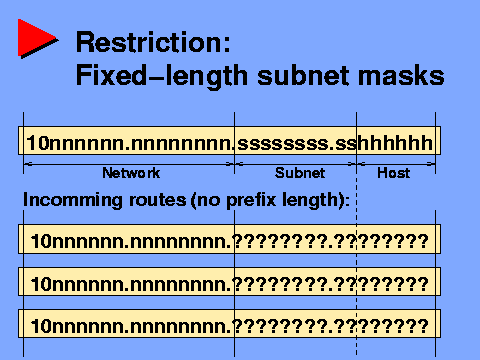Connected: An Internet Encyclopedia
Restriction: Fixed-length subnet masks
Up:
Connected: An Internet Encyclopedia
Up:
Programmed Instruction Course
Up:
Subnetting and CIDR
Prev: Restriction: Subnets within networks
Next: Restriction: Contiguous Subnets

Restriction: Fixed-length subnet masks
Because the older, classful routing protocols don't convey
prefix lengths, routers using these protocols have no way
of knowing the prefix lengths of incoming routes! Therefore,
they have no choice but to assume that subnet routes from
different parts of their classful network all use the same
subnet mask that they use. This leads to a further restriction on subnet
design - the same subnet mask must be used throughout the
classful network, a practice called Fixed Length Subnet Masking
(FLSM), as opposed to Variable Length Subnet Masking (VLSM),
supported by the newer, classless breed of routing protocols.
For example, assume that we've assigned a 210.22.75.128/26 subnet.
If we're using RIP (an older, classful, FLSM routing protocol),
we can not now assign 210.22.75.96/28 as another subnet.
Why? Because both subnets are in the same class C network
(210.22.75.0), yet they have different prefix lengths.
FLSM forbids this. We could assign 210.22.75.64/26, however,
since both subnets in the 210.22.75.0 network would share
the same prefix length of 26.
Next: Restriction: Contiguous Subnets
Connected: An Internet Encyclopedia
Restriction: Fixed-length subnet masks

